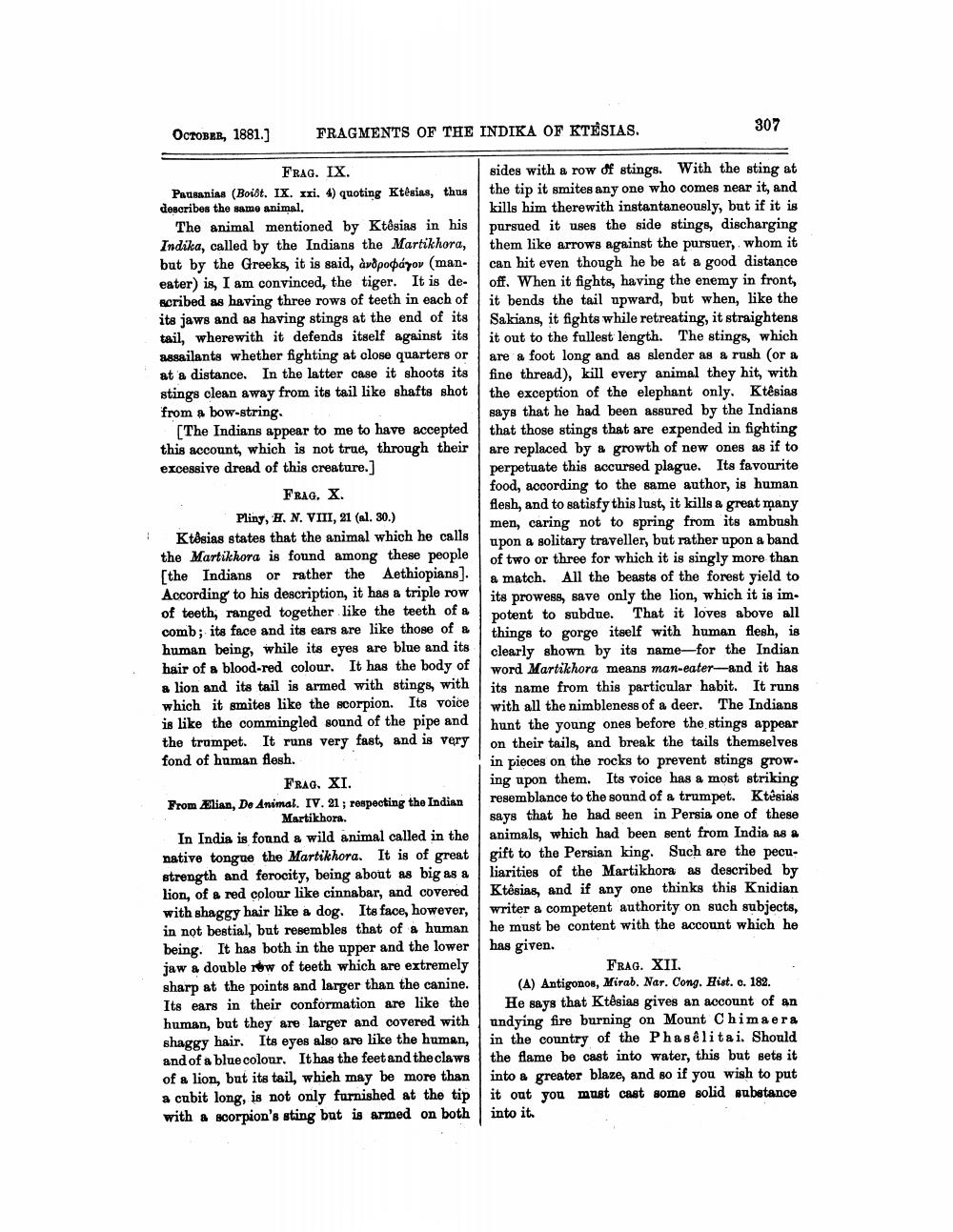________________
OCTOBER, 1881.)
FRAGMENTS OF THE INDIKA OF KTESIAS.
307
FRAG. IX. Pausanias (Boiot. IX. si. 4) quoting Ktésins, thus describes the same animal.
The animal mentioned by Ktêsias in his Indika, called by the Indians the Martikhora, but by the Greeks, it is said, aydpopázov (maneater) is, I am convinced, the tiger. It is described as having three rows of teeth in each of ita jaws and as having stings at the end of its tail, wherewith it defends itself against its assailants whether fighting at close quarters or at a distance. In the latter case it shoots its stings clean away from its tail like shafts shot from a bow-string.
[The Indians appear to me to have accepted this account, which is not true, through their excessive dread of this creature.]
FRAG. X.
Pliny, H. N. VIII, 21 (al. 30.) 1 Ktêgias states that the animal which he calls
the Martikkora is found among these people [the Indians or rather the Aethiopians). According to his description, it has a triple row of teeth, ranged together like the teeth of a comb; its face and its ears are like those of a human being, while its eyes are blue and its hair of a blood-red colour. It has the body of a lion and its tail is armed with stings with which it smites like the scorpion. Its voice is like the commingled sound of the pipe and the trompet. It runs very fast, and is very fond of human flesh.
FRAG, XI. From Alian, De Animal. IV. 21 ; respecting the Indian
Martikhora. In India is found & wild animal called in the native tongue the Martikhora. It is of great strength and ferocity, being about as big as a lion, of a red colour like cinnabar, and covered with shaggy hair like a dog. Its face, however, in not bestial, but resembles that of a human being. It has both in the upper and the lower jaw a double row of teeth which are extremely sharp at the points and larger than the canine. Its ears in their conformation are like the human, but they are larger and covered with shaggy hair. Its eyes also are like the human, and of a blue colour. It has the feet and the claws of a lion, but its tail, which may be more than a cubit long, is not only furnished at the tip with a scorpion's sting but is Armed on both
sides with a row of stings. With the sting at the tip it smites any one who comes near it, and kills him therewith instantaneously, but if it is pursued it uses the side stings, discharging them like arrows against the pursuer, whom it can hit even though he be at a good distance off. When it fights, having the enemy in front, it bends the tail upward, but when, like the Sakians, it fights while retreating, it straightens it out to the fullest length. The stings, which are a foot long and as slender as a rush (or a fine thread), kill every animal they hit, with the exception of the elephant only. Ktêsias says that he had been assured by the Indians that those stings that are expended in fighting are replaced by a growth of new ones as if to perpetuate this accursed plague. Its favourite food, according to the same author, is human flesh, and to satisfy this lust, it kills a great many men, caring not to spring from its ambush upon a solitary traveller, but rather upon a band of two or three for which it is singly more than a match. All the beasts of the forest yield to its prowess, save only the lion, which it is impotent to subdue. That it loves above all things to gorge itself with human flesh, is clearly shown by its name-for the Indian word Martikhora means man-eater--and it has its name from this particular habit. It runs with all the nimbleness of a deer. The Indians hunt the young ones before the stings appear on their tails, and break the tails themselves in pieces on the rocks to prevent stings grow. ing upon them. Its voice has a most striking resemblance to the sound of a trumpet. Ktégials says that he had seen in Persia one of these animals, which had been sent from India as a gift to the Persian king. Such are the peculiarities of the Martikhora as described by Ktosias, and if any one thinks this Knidian writer a competent authority on such subjects, he must be content with the account which he has given.
FRAG. XII. (A) Antigonos, Mirab. Nar. Cong. Hist. o. 182. He says that Ktësias gives an account of an undying fire burning on Mount Chimaera in the country of the Phaselitai. Should the flame be cast into water, this but sets it into a greater blaze, and so if you wish to put it out you must cast some solid substance into it.




